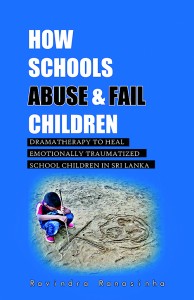Imparting an all important lesson
View(s):Author and educationist Ravindra Ranasinha’s new publication brings into focus our country’s ailing education system which he marks with a ‘Grade F.’ He kicks off his narrative with a well-aimed penalty at bullying in schools. Most parents point out the reality that if teachers were really keeping a close eye on the high jinks around the school, there wouldn’t be any bullying going on in the first place.
They maintain the only reason bullies can exist is because teachers do not pay attention to what happens outside the classroom most of the time. Then again the author raises the relevant question: But what if your child’s teacher is the bully? Certainly, the author will not be in the running if it comes to a popularity poll among his fellow educationists who subscribe to the ‘spare the rod and spoil the child’ philosophy.
For instance the author himself extracts certain sketches of a painful past in which the cane held sway as the order of the day. He states, “For years from the fourth grade to the ninth grade, I lived through teachers’ cruelty. Even though they made me suffer, to my knowledge I had no deficiency. It was how they viewed me.” It is true that there was not much margin for error in that time and place and corporal punishment even for the slightest infraction was the norm.
British-style formal caning was fully lawful in Ceylon schools then and strongly supported by the government. Most of the country’s secondary schools used the cane, which was a significant element in the disciplinary system. But such punishment rarely fitted the crime and provided a free rein for appalling abuse by many tyrannical pedagogues.
The author highlights the truism that teachers can make or break a child. But now although corporal punishment is banned in schools, we observe that it still persists. Ranasinha cites several case studies of children who have been subjected to unspeakable brutality and physical and psychological abuse.
Which brings us to a most pertinent question: Why teachers who use physical violence to discipline their charges are not slapped with charges of criminal offences and hounded out of the profession for good? That is because the majority of teacher bullying may go unreported for several reasons. The victims may not trust the system to support or believe them. They may also fear being singled out for retribution by the executor in the form of lowering their grades or more discrimination.
So it stands out with startling clarity that we are faced with the unpalatable truth that social abuse is part of our nation’s conventional education system. Also parents take a wishy-washy attitude to it. Naturally, when the physical bullying gets intolerable no right-thinking parent would hesitate to report such atrocities.
But when the harassment is emotional or verbal, they often aren’t sure how to react. One concern is that teachers will retaliate and make things worse for their child. While this is a valid concern, it is never a good idea to ignore the situation.
Now, in his new book, Ravindra Ranasinha attacks the problem head-on. Every aspect from physical to sexual and emotional abuse, to romantic adolescent crushes and suicides, mental health, home violence and broken families is dealt with comprehensively.
The document is well compiled with arduous research and fortified with several case studies that clearly sound out the dangerous psychological perspectives of such enforced trauma. It also contains extensive expert references which are attributed in indexes at the end of the book.
Then in conclusion the writer provides the prescription of his favourite healing panacea for the scarred minds of all victims pursued by such afflictions in the form of dramatherapy. His last book on the subject of Dramatherapy has been a best-seller. We are made aware that dramatherapy is essentially a creative healing remedy that uses the performing arts to promote psychological, emotional and social curing change.
The author places the blame squarely on the existing educational system. At the same time he demands rapid reforms to ensure the emotional and psychological interests of school children.
The study is an invaluable handbook for the entire educational shebang including ministry and department mandarins, administrators, principals and gurus. That is because the author being a victim of such abuse and subsequently a benevolent teacher himself identifies where our educational system has gone wrong and what all such authorities should do to remedy it.
The truth is, children can experience physical, emotional, and even sexual abuse at the hands of students as well as teachers. The research demonstrates that abuse of all forms undermines self esteem, lowers learning ability, causes depression, and contributes to long term social problems. Ranasinha poses the relevant question that it is about time we recognised the horror gauntlet our children are being forced to run. Shouldn’t everyone concerned make a combined effort to ensure our children are safeguarded from such sadistic hurt both physically and emotionally?
What the author is basically attempting to enumerate is that empathy should be an intrinsic part of the education system. If schools are required to engage in generating intellectual development, they must inherently be equally involved in fostering emotional development. Educators must be able to connect to and understand their charges in order to best serve those students’ needs and focus on nurturing learning rather than judging performance.
But to do that we first have to exorcise those bullying teachers from our educational system. There can be no compromise about that!
| Book facts
How schools abuse and fail children by Ravindra Ranasinha. Reviewed By Gaston de Rosayro |


